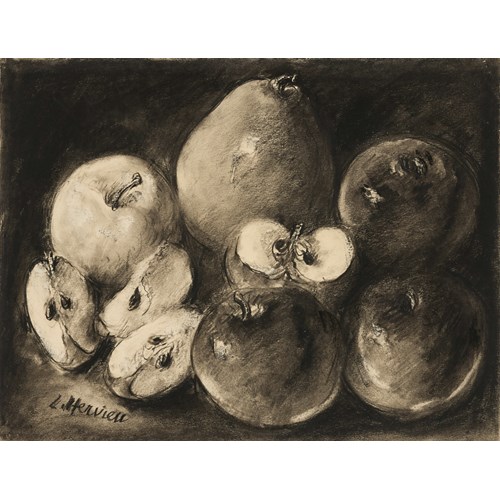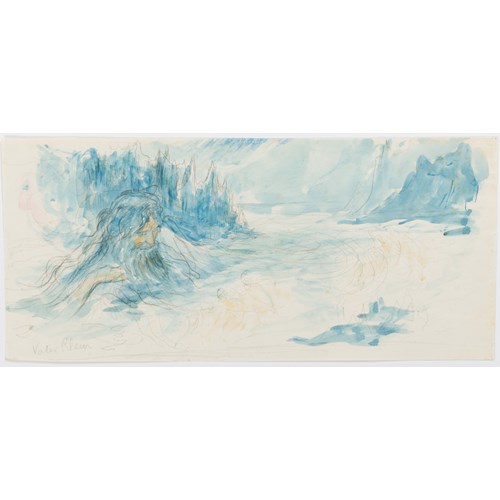Andrea LILIO
An Angel Seated on a Cloud and Playing the Violin
Medium Black chalk, with touches of red chalk, squared for transfer in black chalk, on blue paper
Dimension 15.8 x 11.4 cm (6¹/₄ x 4¹/₂ inches)
The present sheet can be compared stylistically with a squared drawing of three music-making angels by Lilio in the Louvre. Likewise in black chalk on blue paper, the Louvre drawing is the study for the upper part of an altarpiece of Saints John the Baptist, Francis of Assisi, Bernardino of Siena and Paul Adoring the Cross, painted in the mid-1590s for the church of San Francesco in Ancona and now in the Pinacoteca Civica there. Indeed, the pose of the angel in this drawing is similar to that of the central angel playing a violin in the Ancona painting.
Among other stylistically comparable drawings by Lilio is a study in black chalk of a Dead Christ in the Museum Boijmans-van Beuningen in Rotterdam, which is preparatory for a Pietà with Saints, signed and dated 1596, that is today in the Pinacoteca Civica in Bagnacavallo, and a squared drawing of Saint Irene and Others Tending to the Wounds of Saint Sebastian in the J. Paul Getty Museum in Los Angeles.
Likewise comparable is a drawing of Saint Peter of Alcántara Giving Communion to Saint Teresa of Avila, in black chalk on blue paper, in the Biblioteca Nacional de España in Madrid, and a squared study of A Seated Evangelist in the same technique, in the Teyler Museum in Haarlem, as well as an Assumption of the Virgin, in the Museo del Prado in Madrid, which is a compositional study for an altarpiece of 1604 in a church in the coastal town of Numana, south of Ancona.
The present sheet was once part of the collection of the art historian, museum curator, patron and cultural broadcaster Sir Kenneth Clark, later Lord Clark of Saltwood (1903-1983). Clark, who served as Director of the National Gallery and Keeper of the King’s Pictures between 1934 and 1945, and later as chairman of the Arts Council, began collecting while a student at Oxford, and eventually assembled a small but choice group of Old Master and British drawings, as well as paintings, sculptures, illuminated miniatures and works of art dating from the Renaissance to the 1940s.
Medium: Black chalk, with touches of red chalk, squared for transfer in black chalk, on blue paper
Dimension: 15.8 x 11.4 cm (6¹/₄ x 4¹/₂ inches)
Provenance: An indistinct collector’s mark(?) stamped in red ink at the lower right
Sir Kenneth Clark, Lord Clark of Saltwood, London and Saltwood Castle, Kent
His posthumous sale, London, Sotheby’s, 5 July 1984, lot 168
Anonymous sale, London, Sotheby’s, 4 July 1988, lot 29
Private collection, Germany
Colnaghi / Katrin Bellinger, London, in 2004
Acquired in 2006 by Herbert Kasper, New York
Thence by descent.
Literature: Mario di Giampaolo, ed., Disegno italiano antico: Artisti e opere dal Quattrocento al Settecento, Milan, 1994, illustrated p.160; Mario di Giampaolo, ‘Per Andrea Lilio disegnatore e una precisazione per il Cantarini’, in Disegni marchigiani dal Cinquecento al Settecento: Atti del Convegno “Il Disegno antico nelle Marche e dalle Marche”, 1995, p.78, fig. 2, reprinted in Cristiana Garofalo, ed., Mario Di Giampaolo: Scritti sul disegno italiano 1971-2008, Florence, 2010, p.300, fig.1; Massimo Pulini, Andrea Lilio, Milan, 2003, pp.200-201, no.10, and p.158, under no.59 (‘un bellissimo e spedite studio’).
Exhibition: New York and London, Colnaghi, Master Drawings, 2004, no.10.
Plus d'œuvres d'art de la Galerie






-DELLE SITE-Sogno dell’ aviere (The Dream of the Airman)_T638114469830049470.jpg?width=500&height=500&mode=pad&scale=both&qlt=90&format=jpg)


